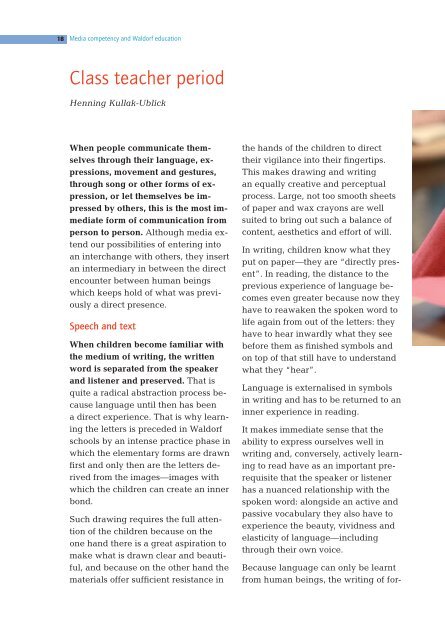Struwwelpeter 2.0
Struwwelpeter_engl_August_2015
Struwwelpeter_engl_August_2015
- No tags were found...
Create successful ePaper yourself
Turn your PDF publications into a flip-book with our unique Google optimized e-Paper software.
18<br />
Media competency and Waldorf education<br />
Class teacher period<br />
Henning Kullak-Ublick<br />
When people communicate themselves<br />
through their language, expressions,<br />
movement and gestures,<br />
through song or other forms of expression,<br />
or let themselves be impressed<br />
by others, this is the most immediate<br />
form of communication from<br />
person to person. Although media extend<br />
our possibilities of entering into<br />
an interchange with others, they insert<br />
an intermediary in between the direct<br />
encounter between human beings<br />
which keeps hold of what was previously<br />
a direct presence.<br />
Speech and text<br />
When children become familiar with<br />
the medium of writing, the written<br />
word is separated from the speaker<br />
and listener and preserved. That is<br />
quite a radical abstraction process because<br />
language until then has been<br />
a direct experience. That is why learning<br />
the letters is preceded in Waldorf<br />
schools by an intense practice phase in<br />
which the elementary forms are drawn<br />
first and only then are the letters derived<br />
from the images—images with<br />
which the children can create an inner<br />
bond.<br />
Such drawing requires the full attention<br />
of the children because on the<br />
one hand there is a great aspiration to<br />
make what is drawn clear and beautiful,<br />
and because on the other hand the<br />
materials offer sufficient resistance in<br />
the hands of the children to direct<br />
their vigilance into their fingertips.<br />
This makes drawing and writing<br />
an equally creative and perceptual<br />
process. Large, not too smooth sheets<br />
of paper and wax crayons are well<br />
suited to bring out such a balance of<br />
content, aesthetics and effort of will.<br />
In writing, children know what they<br />
put on paper—they are “directly present”.<br />
In reading, the distance to the<br />
previous experience of language becomes<br />
even greater because now they<br />
have to reawaken the spoken word to<br />
life again from out of the letters: they<br />
have to hear inwardly what they see<br />
before them as finished symbols and<br />
on top of that still have to understand<br />
what they “hear”.<br />
Language is externalised in symbols<br />
in writing and has to be returned to an<br />
inner experience in reading.<br />
It makes immediate sense that the<br />
ability to express ourselves well in<br />
writing and, conversely, actively learning<br />
to read have as an important prerequisite<br />
that the speaker or listener<br />
has a nuanced relationship with the<br />
spoken word: alongside an active and<br />
passive vocabulary they also have to<br />
experience the beauty, vividness and<br />
elasticity of language—including<br />
through their own voice.<br />
Because language can only be learnt<br />
from human beings, the writing of for-


